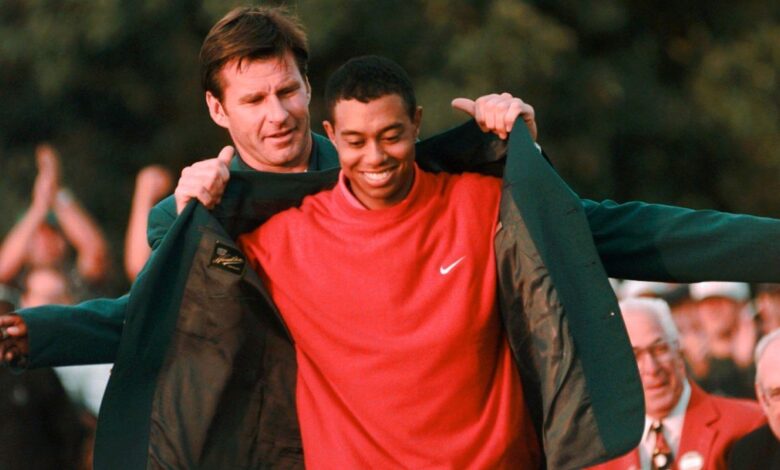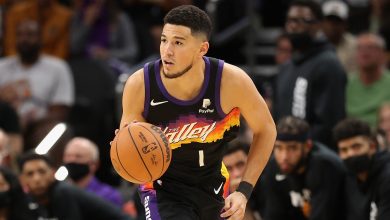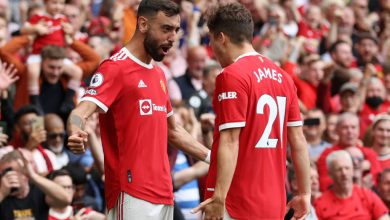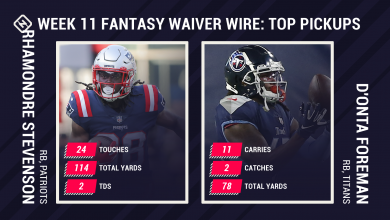‘He left us in the dust’

AUGUSTA, Ga. — As Mark O’Meara approached the tee box of the 15th hole at Augusta National Golf Club during the first round of the 1997 Masters, he saw Tiger Woods sitting on a bench.
O’Meara, one of Woods’ closest friends and a mentor during the early years of Woods’ PGA Tour career, sat down next to him.
“Really?” O’Meara asked Woods.
“Yeah, what?” Woods replied.
“Dude, what’s going on, man?” O’Meara said. “You never play like this when you play with me at home. All you need to do is pretend like you’re playing against me. You shoot 59, you make birdies, you make holes-in-one. I mean, gimme a break.”
Only six days earlier, on April 4, 1997, O’Meara had played a round with Woods at their home course, Isleworth Country Club in Windermere, Florida. Woods shot 59 on the par-72 course, the only time he has achieved golf’s magic number during a career in which he has won a record-tying 82 PGA Tour events and 15 major championships. They played again the next day — O’Meara left after Woods made birdie on the first hole and a hole-in-one on the second.
Then, less than a week later, in his first appearance as a professional at the Masters, Woods’ game was out of sorts. Playing with defending champion Nick Faldo, Woods hooked his opening tee shot left and was forced to chip out. He ended up bogeying the first hole — and then the par-3 fourth, par-5 eighth and par-4 ninth. He didn’t make a birdie and shot 4-over 40 on the first nine holes.
“He wasn’t down in the dumps,” O’Meara recalled. “Not shellshocked, but he definitely was not happy and a little disappointed that he hadn’t gotten off to a better start. He wouldn’t have said that, but by knowing him — his emotions and things — it kind of showed when he was sitting next to me.”
Twenty-five years later, what happened over the 63 holes that followed in the 1997 Masters is still the stuff of legend. As O’Meara offered encouragement, he couldn’t have known that Woods was getting ready to run away from the field in a record-shattering victory that would become the coronation of a worldwide superstar and change golf forever.
Woods would end up setting the Masters Tournament scoring record of 18-under par 270 to become the youngest man to win a green jacket at 21. He was 22 under over those final 63 holes. Along the way, Woods set 20 Masters records and tied six others in what would be the first of five victories at Augusta National.
His history at the Masters gets another unexpected twist this week, as Woods is seemingly ready to return to action after a 14-month layoff since suffering serious injuries in a car wreck on Feb. 23, 2021. It would be his first start in more than 500 days.
2022 MASTERS: TEE TIMES, TELEVISION COVERAGE AND MORE
“He went out in 40 and back in 30 and then we didn’t see him for the next 14 years,” Faldo said in 2017. “He left us in the dust.”
On the silver anniversary of Woods’ historic victory at the 1997 Masters, people who had front-row seats at Augusta National — his competitors, caddies, TV announcers, reporters and Woods himself — recall that week and, especially, those first 18 holes. Their memories come from new interviews, previous comments from an ESPN documentary about Woods, and Tiger’s recollections in his 2017 book, “The 1997 Masters: My Story.”
‘It was so total Tiger it was annoying’
Coming into the 1997 Masters, Woods’ competitors didn’t know if he was ready to compete for a green jacket — they just knew they were tired of hearing about him.
“Going in, it was, ‘What do you think of Tiger?'” Faldo said. “[The media] didn’t ask you anything [about yourself]. It was so total Tiger. It was unbelievable. It was so total Tiger it was annoying. He came in with such major attention.”
While at Stanford, Woods became the first player to win three consecutive U.S. Amateur titles. In June 1996, he won an NCAA individual championship. The next month, he won the silver medal as the low amateur at The Open at Royal Lytham & St. Annes, tying for 22nd and shooting 5-under 66 in the second round.
With the announcement, “Hello, world,” Woods turned pro on Aug. 29, 1996. He won twice as a rookie on the PGA Tour and again at the Mercedes Championships (now the Sentry Tournament of Champions) in Hawaii in January 1997.
“There was a lot of anticipation and a lot of expectations and excitement,” said Fanny Sunesson, who was Faldo’s caddie in 1997. “But you really didn’t know. To be honest, I don’t remember what he had done before the Masters. There was a buzz in the air and the tournament had something special.”
As good as Woods had been over the first seven months on tour, Faldo and other pros wondered aloud if he was ready for the pressure that came with playing at Augusta National. Woods had never broken par in six rounds as an amateur and had missed the cut by 4 shots just the year before, when Greg Norman infamously blew a 6-shot lead in the final round and Faldo won his third green jacket.
Faldo had once called playing Augusta National a “five-year affair” because that’s how long it took players to figure the place out.
“I think there’s a learning curve of playing Augusta and the discipline of playing the golf course,” Faldo said. “When to hit the ball. When not. When to make par and walk. It’s not impossible, but I think experience does help here.”
Yet, Woods’ inexperience at Augusta didn’t stop oddsmakers from installing him as the betting favorite with Faldo and Norman. The public and media were as equally consumed with Woods, a man of color, who was born the same year, 1975, that Augusta National invited Lee Elder, the first Black player to compete in the Masters. Elder was honored as one of the ceremonial starters, along with Jack Nicklaus and Gary Player, before the 2021 Masters. Less than eight months later, Elder died in November at age 87.
On this day in 1997, it was clear who the patrons came to see.
“On Monday, Tuesday and Wednesday at Augusta National, there’s probably 30,000 to 40,000 [patrons] out there,” O’Meara said. “But when I’m playing with Tiger Woods, they’re six-, seven-deep on every single hole, wanting to see him. It was like a rock star showing up, for sure.”
The previous year, Woods played a practice round with Nicklaus, who has won more major championships, 18, than any other player in history. Nicklaus told Woods that his game was so equipped for the course that he would win as many green jackets as Arnold Palmer and Nicklaus combined. Nicklaus won six Masters; Palmer won four. Nicklaus told the media as much before the opening round in 1997.
“He’s playing really well, but Augusta takes a lot of local knowledge,” two-time U.S. Open winner Curtis Strange said. “It’s a veteran’s tournament. It’s a veteran’s golf course. This kid is young. He’s really still inexperienced in major championships. All of that hogwash — it didn’t make any difference to Tiger Woods.”
As Woods and Faldo arrived at the first hole for their 12:44 p.m. ET tee time in the first round on April 10, 1997, all eyes were on the 21-year-old in the baggy Nike shirt.
“The storyline was on fire,” CBS announcer Jim Nantz said. “Everybody felt like the coronation was coming at Augusta. I felt it for months leading up to it.”
‘Forty. That’s not a very good start’
When TV coverage of the 1997 Masters started on USA Network on Thursday, Woods and Faldo were standing in the middle of the 10th fairway. Back then, Augusta National Golf Club allowed TV coverage of only the second nine holes. The day before the tournament started, then-Masters chairman Jack Stephens was asked about expanding TV coverage to all 18 holes, like in the U.S. Open.
“Progress is slow because we don’t want to do it,” Stephens said.
Woods was probably happy nobody saw his first nine holes.
“I couldn’t keep the ball in the fairway,” Woods would say after the first round. “From there, you can’t attack these pins, the pins you can attack. I was just playing real defensive golf. … Augusta’s fairways are pretty big and I couldn’t hit them. So obviously, that was pretty bad.”
On the par-4 ninth hole, Woods pulled his tee shot into the trees once again. His approach shot hit the green but then rolled back into the fairway. After a so-so chip, he missed a 10-footer. He settled for a bogey and carded a 4-over 40 on the first nine.
“I knew one thing above all as I walked to the 10th tee: My start wasn’t going to finish me,” Woods wrote in “The 1997 Masters: My Story.” “I didn’t play well at all, not at the start anyway. I shot that 40, and I was bewildered and furious as I walked to the 10th tee. I was trying to think about what had just happened. I needed to figure out what went so wrong on the front nine.”
Woods’ problems off the tee had to be driving him mad. There had been nothing wrong with his swing in practice rounds or on the range in the days leading up to the tournament. He was confident in his swing going into his first major championship as a professional, but not so much in his putting.
25 years ago, Tiger Woods won his first Green Jacket.
The game would never be the same. #themasters pic.twitter.com/3TJ9FarDbs
— The Masters (@TheMasters) April 4, 2022
The night before the first round, Woods stood in the bedroom where his father, Earl, was sleeping. Earl Woods was recovering from triple bypass surgery in February 1997. Earl’s doctor had urged him not to travel to Augusta, but he wasn’t going to miss his son’s first Masters as a professional.
“Now, the evening before the first round, he was in bed,” Woods wrote in his book. “I needed help. I grabbed three balls and got into my putting posture as he lay there in bed, and asked him if he saw anything.”
Earl Woods told his son, “Your hands are too low. Lift them up. Get that little arch in your hands like you always do.”
It was a good tip. Woods putted well on the first nine holes, but everything else seemed off in his game. As Woods walked to the 10th, his caddie, Mike “Fluff” Cowan, offered him a few words of encouragement.
“That’s just the front nine,” Cowan told him. “There’s a long way to go in this golf tournament. Just hang in there, see if we can shoot something under par in the second nine, and we’ll be alright.”
Tiger wasn’t the only one surprised by his score.
“You know, I saw when he was 4-over par, I’d started chuckling,” said Paul Stankowski, who had the lead for much of the first round. “I thought, you know, ‘Nice play, kid,’ you know? I think I shot one or two under on the front nine. I’m thinking, ‘Forty? That’s not a very good start.'”
Cowan had worked with Peter Jacobsen for nearly two decades before moving to the hotshot Woods’ bag in 1996. He would become the most famous caddie on tour while teaming with Woods until they split in 1999. As they made the turn in 1997 at Augusta National and headed for the most famous nine holes in golf, Cowan wasn’t overly concerned about the way Woods was playing.
“It’s golf,” Cowan said. “It doesn’t always go the way you want it to go. I do know how valuable shooting par is around Augusta. I knew what was ahead of us on the back nine: Two par-5s where he can easily make birdies, so all of a sudden we’re playing a par-34 back nine. And if we shoot 74, a couple over, you’re not out of the golf tournament. And if we can do something better than that, we’re right in the midst of it.”
For Woods to do that, however, he had to figure out what was happening with his swing on tee shots. In the blink of an eye, he fixed it.
“I decided that my backswing got too long on the front nine, and I didn’t like that feeling,” Woods wrote in his book. “I didn’t like it when my backswing even got to parallel. I got out of sync then, and I had to get back on the right path to the ball by using my arms alone, rather than allowing my lower body to carry them through.
“Swinging that way meant I had to depend on my timing, which wasn’t reliable. I wanted my swing to feel tight. This provided me the control I craved. But by control I didn’t mean that I was swinging freely. I could make an uninhibited swing at my best, without mechanical thoughts. I wanted that feeling.”
Butch Harmon, who was Woods’ swing coach at the time, was walking in the gallery, but wasn’t allowed to say anything to him.
“You know your golf swing,” Harmon said. “Here are the two things [you teach] when you’re dealing with the best players in the world. You need to teach them how to self-correct during the course of a round. Meaning, you’ve got to know when you’re hitting a bad shot, why you’re hitting them, and what you have to do to change it.
“It’s not as easy as just saying, ‘OK, I need to do this.’ You can feel when you’re out of sync [and] you’re out of position. In his case, the club was a little too far behind him because his body rotation is so fast. You’ve heard him talk about it for years. When he gets bad, he gets stuck.”
More than anything else, according to Harmon, his star pupil just needed to calm down.
“He was amped up and ready to play,” Harmon said. “He just was racing. He just wasn’t being himself. I think actually shooting 40 on the front nine turned out to be a good thing. It was kind of a slap in the face, like, ‘Hey, you’re this great player, but this course isn’t just going to let you take it. You’ve got to go out and earn this.'”
‘I let go of the anger’
Woods wasn’t the only player who had struggled on the first nine. When TV coverage started, only eight players were under par. With winds of 15 to 18 mph swirling from the southwest, club selection became a guessing game. The winds were also drying out Augusta National’s greens, which were already some of the most treacherous putting surfaces in the world. Fred Couples said the greens were “like concrete.” Ken Green, then one of the better putters on tour, five-putted the 16th green from 6 feet and had 44 putts in his round. Faldo had 20 putts while shooting 5-over 41 on the first nine.
As Woods stepped to the 10th tee, he knew he was still in contention, even at 4 over.
“Just before I stepped on the 10th tee, I let go of the anger, and calmed myself,” Woods wrote in his book. “I was thinking of the feeling I had the week before at Isleworth, when I hit one perfect shot after another. The feeling washed over me. My heart rate slowed. I felt the motion of my swing, and the tightness I wanted, the sense of controlled power through the ball. I felt free.”
Woods knocked his tee shot with a 2-iron down the middle of the fairway. He hit his approach shot to 15 feet and rolled in a birdie putt to move to 3 over.
“I knew it, from that one swing on the 10th tee,” Woods wrote. “Sometimes in golf everything can turn around, for better or worse, with one swing. This was the swing that was going to turn it around for me.”
After making par at the 11th, Woods seemed to make a big mistake when he hit his tee shot over the green on the par-3 12th. He faced a difficult chip shot from 35 feet and back toward Rae’s Creek. Somehow, he hit a perfect bump-and-run shot with a 9-iron and the ball tumbled into the hole for a birdie. He raised both hands over his head and delivered a fist pump, which would become a trademark celebration for decades to come.
“We watch Tiger bogey the first hole,” Nantz recalled. “We watch him shoot 40 on the first nine. And then all of a sudden at the 12th hole, things just kind of flipped.”
On the par-5 13th, the final test in the three-hole stretch famously known as Amen Corner, Woods’ second shot with a 6-iron from 196 yards landed on the green. He two-putted for a birdie and was just 1 over for the round.
On the par-5 15th, after bumping into his good friend O’Meara, Woods blistered a 349-yard drive over the crest of the hill in the fairway. Left with 151 yards to the hole, he hit pitching wedge to 4 feet. Woods knocked in the eagle putt — and pumped his right fist again — to go under par for the first time that week. He was just 2 shots behind leader Paul Azinger after 15 holes.
Woods made par at the 16th and then, after hitting a lob wedge from 87 yards, he made a 12-foot birdie putt on the par-4 17th to improve to 6 under on the second nine.
Heading to the par-4 18th, Woods needed a birdie to tie Mark Calcavecchia‘s record of 7-under 29 over the second nine holes in the final round in 1992 (David Toms would tie the mark in the final round of 1998). Woods’ 12-foot birdie putt slid past the hole on 18. He settled for 6-under 30 on the second nine and 2-under 70 for the round.
‘He had an aura’
To say Woods was just getting started would be like saying the pollen at Augusta National makes you sneeze. He played with Azinger in the second round (the Masters re-paired players by scores after each round back then) and trailed leader John Huston by 3 shots.
Azinger, the 1993 PGA Championship winner, had never played with Woods and hadn’t even seen him hit balls on the range. On the second hole, Azinger told his caddie, Mark Jimenez, “You know, I’ve never seen this guy hit a shot. I’m going to watch this shot.”
“I got my arms folded with a little bit of an attitude, like, ‘You know, let’s just see what this guy’s all about,'” Azinger said. “And he hits this tee shot down the left side. It felt like it was this far to the right of that bank of pine trees. And it felt like it was this far below the top of those pine trees. And it was the most dead-straight rocket tee shot I’d ever seen in my life. I looked at my caddie and I was like, ‘Holy crap.’ I couldn’t believe it. I’d never seen a ball leave like that.”
With five birdies, one eagle and just one bogey, Woods shot 6-under 66 in the second round to take a 3-shot lead over Colin Montgomerie after 36 holes. When Woods grabbed his first lead with an eagle putt on the par-5 13th hole, Nantz opened his microphone and said on TV, “Let the record show, a little after 5:30 on this Friday, April the 11th, Tiger takes the lead for the first time ever at the Masters.”
“I wanted to kind of mark that moment in history,” Nantz said. “Because what I was really saying was, ‘This is gonna happen a whole lot. This is gonna happen many times in the years to come, but this is the first time. Mark that point in history.'”
After the round, Montgomerie said he believed the pressure would get to Woods on the weekend.
“There’s more to it than hitting the ball a long way, and the pressure’s mounting more and more,” Montgomerie said. “I’ve got more experience, a lot more experience, in major championships than he has. And hopefully I can prove that.”
Instead, Woods had a bogey-free round of 7-under 65 to move to 15 under after 54 holes. He missed just one fairway and one green in the third round. His lead increased to 9 shots over Italy’s Costantino Rocca. Montgomerie was the player who buckled while playing with Woods, shooting 2-over 74, to fall into a tie for sixth at 3 under. Suddenly, the Scotsman was a believer.
“There is no chance,” Montgomerie said after the third round. “We’re all human beings here. There’s no chance humanly possible that Tiger is going to lose this tournament. No way.”
Of course, Montgomerie was right. With a final round of 3-under 69, Woods set the Masters’ 72-hole scoring record of 18-under 270. He was 16 under over the final 54 holes. His 12-shot victory was the largest in any major championship since the 1862 Open at Prestwick, which Tom Morris Sr. won by 13 shots. Woods would later win the 2000 U.S. Open at Pebble Beach by a whopping 15 strokes.
“It just felt like you could have hit him on the head with a baseball bat that week and it would have just bounced off,” said David Feherty, who was working the 15th hole at Augusta National in his first season with CBS Sports in 1997. “He had an aura that week. He just looked completely unbreakable. After I interviewed him on the first day, I thought, ‘Well, this kid has got something really special.’ He just had that look in his eye and that sense of greatness around him.”
‘What he did next is history’
Woods’ record-setting performance at the 1997 Masters was just the beginning of a career in which he would win 15 major championships, including five Masters titles, and a record-tying 82 times on the PGA Tour. He was inducted into the World Golf Hall of Fame in March.
After Woods won a second green jacket in 2001 with a 72-hole total of 16-under 272, Augusta National famously “Tiger-proofed” its course. In an effort, in part, to keep Woods from continuing to dominate the most fabled golf course in the world, Masters officials moved back tees and added nearly 300 yards in length. They added trees to the sides of fairways to make them narrower. Despite their efforts, he won three more green jackets.
That memorable week in April 1997 inspired future PGA Tour players from around the world.
Rory McIlroy, then 7, was watching Woods’ dominance on BBC at home in Northern Ireland. He, too, remembers Thursday, what happened and its significance.
“I watched it all,” McIlroy said. “He shot 40 on the front nine on Thursday, came back in 30, and then just completely blitzed the field after that. Yeah, it was just a complete master class. … I remember sitting on the sofa with my dad and watching it and being able to stay up late to watch him win on a Sunday night before having to go to school on Monday.”
Growing up in San Diego, Charley Hoffman had heard about Woods winning junior tournaments since he was 6. Woods grew up in Southern California and is a year younger than Hoffman. In his second season at UNLV, Hoffman watched the 1997 Masters at a friend’s home in Santa Barbara, California.
“You know what I remember more than anything?” Hoffman said. “His horrible start. Everybody was like, ‘Oh, no.’ And then obviously what he did next is history. He had that terrible start and then his next 63 holes are probably some of the best golf to ever be played.”
Gary Woodland, the 2019 U.S. Open winner, was more interested in basketball and other sports while growing up in Topeka, Kansas. That was until he watched the 1997 Masters as a 12-year-old.
“It was the first golf tournament I paid attention to,” Woodland said. “After he won, I bought the VHS tape and watched it a million times. Where I grew up, playing golf wasn’t cool. Golf became a little bit cooler, and you weren’t too ashamed to say you were a golfer after that. He changed the game for all of us.”
Brandt Snedeker, a 13-time time winner on the PGA Tour, was still in high school in Nashville, Tennessee, when Woods won in 1997. He remembers playing golf that morning, before running home to watch the final round.
“Golf was more of a niche sport at that time,” Snedeker said. “Tiger kind of changed the way everybody looked at everything. I don’t ever remember Nicklaus or Palmer winning AP Male Athlete of the Year, and it seemed like Tiger did it 10 straight years after that. It just changed the way people view golf. It became something cool and different.”
Now, a quarter-century after Woods’ first victory at Augusta National, his competitors and golf fans around the world are anxiously waiting for his potential return.
“He made golf, at the highest level, a very, very attractive thing to be involved in,” McIlroy said. “TV paid more. Sponsors paid more. And then all of a sudden, his peers and colleagues and other players were getting paid more because of that. I think we all have to be very thankful for Tiger Woods and when he came along, and we should all be very fortunate that we played at a time that he was around because we’ve all benefited from him.”
Woods and every PGA Tour player who followed him has benefitted from that historic day in April 1997, which started with a whimper and ended with a boom. Even those who were there that day couldn’t have fully known the effect it would have.




